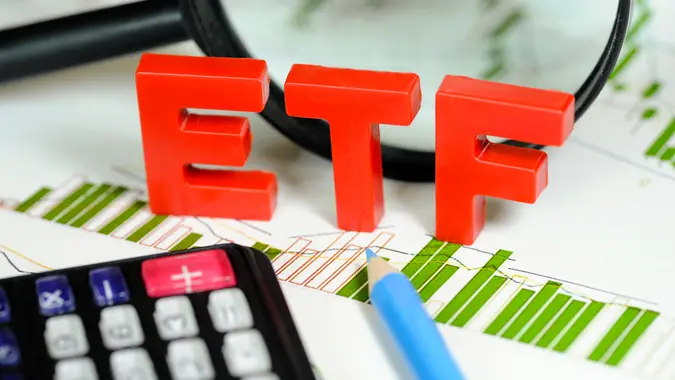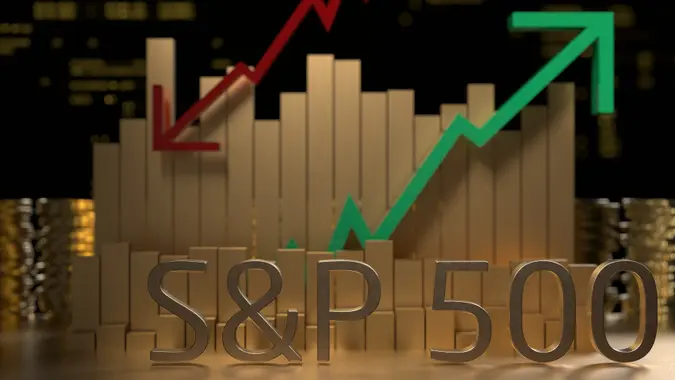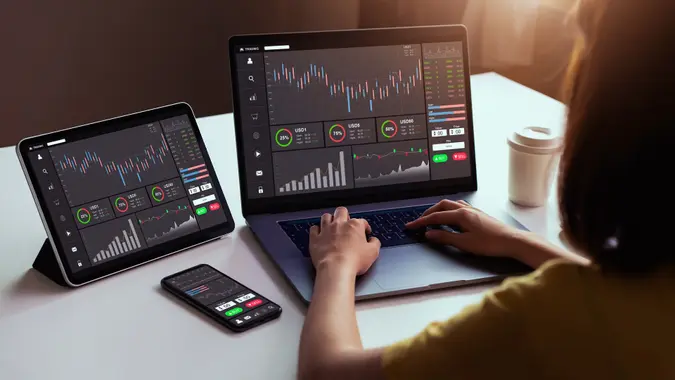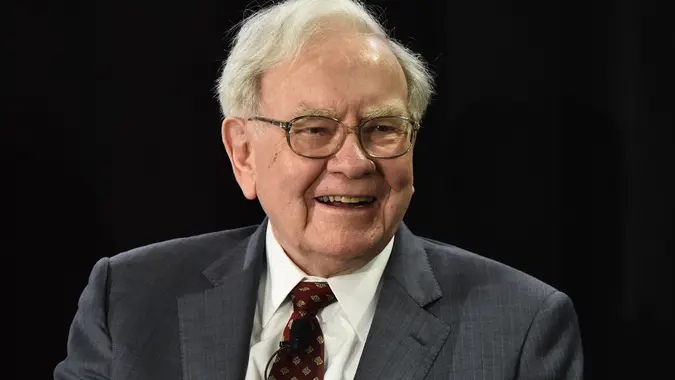10 Best Investments for 2024

Commitment to Our Readers
GOBankingRates' editorial team is committed to bringing you unbiased reviews and information. We use data-driven methodologies to evaluate financial products and services - our reviews and ratings are not influenced by advertisers. You can read more about our editorial guidelines and our products and services review methodology.

20 Years
Helping You Live Richer

Reviewed
by Experts

Trusted by
Millions of Readers
Trying to pick the one or two investments that will make you the most money right now can feel like a fool’s errand. After all, a predicted recession hasn’t happened, and it seems unlikely it will. Since no one can predict what scenario will play out over the next six months, it’s best to consider a variety of investments that collectively can provide you with income, safety and the potential for growth.
What Are the Best Investments for 2024?
If you’re on the lookout for investment opportunities, here’s a look at 10 of the best investments you can consider for your portfolio.
1. High-Yield Savings Accounts
A high-yield savings account pays higher-than-average interest rates, so your money grows faster than it would in a traditional savings account paying average rates. The account is fully liquid, meaning you can withdraw your money whenever you want.
Although you can find high-yield savings accounts at brick-and-mortar banks like Capital One, online banks and credit unions typically pay the highest rates.
Why We Like Them
For more conservative investors, there’s rarely been a better time to keep your money in a high-yield savings account than now.
High-yield savings yields skyrocketed amid the Federal Reserve’s aggressive rate hikes in 2022 and 2023. In 2020, rates on even the best high-yield savings accounts were about 0.50%. Now you can find accounts paying 4% or even more, even though the Fed has already begun to cut interest rates.
That’s a pretty high yield for an insured savings account, considering that the average savings account rate is just 0.45% as of Oct. 21, 2024, making it a good place to hide if you’re worried about a stock market sell-offs in 2024 or 2025.
What To Watch Out For
Your money is safe in a high-yield savings account — there’s no chance of losing your principal up to the coverage limit or the interest it earns even if the bank fails. This is because your accounts are insured for up to $250,000, and some banks offer even more insurance than that.
However, savings accounts of all types carry inflationary risk, which is a loss of purchasing power due to inflation. The inflation rate is 2.4% as of September, so your account must yield at least that much to retain its purchasing power.
2. Individual Stocks
Individual equities are an exciting way to potentially generate capital gains for your account. Many investors enjoy owning shares of companies they are familiar with and use in daily life, such as Apple, and participating in their upside can be both profitable and enjoyable.
Why We Like Them
Stocks generally have a higher long-term average return than most other investments, such as bonds and savings accounts. They’re also a good hedge against inflation. If you pick the right stocks, you can earn long-term, outsized gains.
Market darling Nvidia, for example, has posted a staggering total return of over 30,000% over the past decade. That translates to an average annual return of more than 77%. For context, this is about 6x the S&P 500’s 13% yearly return over the same period.
What To Watch Out For
Stocks are inherently volatile, particularly the ones like Nvidia that can potentially post huge upside gains. Unlike the broad market averages, which have always gone on to make new highs after a bear market, many individual stocks never recover, with some going bankrupt.
3. Corporate Bonds
A corporate bond is like an IOU. Companies issue them to generate cash they can use for a variety of purposes, such as:
- Expanding the business
- Investing in equipment
- Paying shareholder dividends
- Buying back shares of their stock
By purchasing bonds, investors essentially loan the company money in exchange for the company’s obligation to pay the investors interest on their principal and, in most cases, pay back the principal when the bond matures.
Bonds and the companies that issue them receive credit ratings based on their risk of defaulting on their obligations to bondholders. Investment-grade bonds have stronger credit ratings and are safer than non-investment-grade bonds.
Whichever type you choose, investing in a bond fund is less risky than investing in individual bonds of the same type because funds have built-in diversity — a small number of companies in a fund might default, but it’s unlikely that all will.
Why We Like Them
A corporate bond does not offer a huge amount of upside, but protecting you from the potential downside of the stock market may end up being the winning move. Corporate bonds provide a modest amount of income in exchange for the security of getting your money back at maturity.
In recent months, yields have actually risen on corporate bonds as investors have sold bonds and bought stocks. If the fulcrum tilts the other way, investors can benefit from both higher income and potential capital gains — although that would require a sale before maturity.
What To Watch Out For
Bonds are generally low risk, but not as low risk as savings accounts and CDs. Like those products, bonds have inflationary risk that can erode their purchasing power.
They also have interest rate risk — the risk that rates will increase while your money is tied up on the bond. And some bonds allow the company to call them back before the maturity date, which might cause you to miss out on the rate you expected to earn on your investment.
4. Index Funds
Index funds track the performance of an underlying index, such as the Nasdaq-100 or the S&P 500. They are passively managed, meaning managers don’t make any discretionary buy or sell decisions but simply provide the return of the index.
Why We Like Them
Index funds are generally very low-cost vehicles, providing limited drag on investor returns. Most investors, even professional ones, can’t outperform the broad market averages consistently over time, so index funds can be an easy, low-cost way to earn a good return.
The Nasdaq-100 Index, for example, has produced a cumulative annualized return of 18.12% over the last 10 years. The S&P 500 index, which isn’t as volatile as the Nasdaq-100, has also produced stellar average annual returns of 13.0% over the past decade.
The S&P 500 — like every other major market index — has never failed to come back from a bear market and make new all-time highs. Although past performance can’t predict future results, this is an enviable track record and makes an S&P 500 ETF investment a solid long-term bet.
What To Watch Out For
The Nasdaq composite index took the brunt of the bear market in 2022, dropping 33%. It regained those losses to reach record levels in 2024, but you’ll still need a high tolerance for risk to invest in a Nasdaq-100 Index fund. You’ll also have to accept the fact that you’ll never outperform the market, although the returns over the past decade would likely be embraced by most investors.
5. Certificates of Deposit
Certificates of deposit are a specialized type of bank savings account that is insured by the FDIC and makes regular interest payments until it returns an investor’s principal investment at maturity.
Why We Like Them
CDs are safe ways to earn interest on your idle cash. Typically, CDs are issued in shorter maturities, ranging from a few months to a few years, although some banks do offer CDs with maturities of 10 years or even longer. The rate you earn is guaranteed for the life of the CD, regardless of what happens to market interest rates.
What To Watch Out For
Most CDs have early surrender charges, meaning you’ll have to forfeit a chunk of the interest you’ve earned if you sell them before they mature. CDs also generally provide returns in line with the yields on high-yield savings accounts, meaning they’re not a great choice if you’re looking to grow your money over the long run.
6. Money Market Accounts
Money market accounts are somewhat of a hybrid between a checking account and a savings account. They pay higher yields than the average savings account but also typically offer check writing and/or debit card access.
Why We Like Them
Money market accounts are a good way to earn a higher yield on your idle cash while still offering you the ability to occasionally write a check. As savings accounts don’t allow check writing, this gives money market accounts more financial flexibility while still offering the same FDIC insurance.
What To Watch Out For
Many money market accounts have high minimum opening or maintenance balance requirements, often $2,500 or more. This makes them unsuitable for savers with relatively low balances or those who tend to draw down their accounts close to zero every month. Some banks may also restrict the number of checks you can write every month, limiting access to your funds.
7. Dividend Stocks
Dividend stocks — many of which also happen to be value stocks — return a portion of earnings to shareholders. The benefit of holding these stocks is that you earn income (dividends) whether or not the share price appreciates. Dividend Aristocrats are companies that have increased their dividends for at least 25 years in a row.
Why We Like Them
In times of economic uncertainty, companies that pay high dividends tend to hold up better. To consistently pay a high dividend, a company needs a consistent revenue stream, and these are the types of businesses that investors value when the economy slows.
Owning a fund of dividend stocks — especially Dividend Aristocrat stocks — is a good way to diversify your holdings, earn a solid income and protect yourself from the more volatile areas of the stock market.
What To Watch Out For
Focusing too much on dividend yields can be counterproductive. Look at a stock’s potential for capital gains as well as its suitability for your investing goals and risk tolerance.
8. Mutual Funds
There are literally tens of thousands of mutual fund options available to investors, allowing them to select nearly any type of investment style to reach their financial goals. Risk is reduced because funds typically own hundreds of different securities in one package, all managed by professional investors.
Why We Like Them
Mutual funds allow you to own a portfolio of tens, hundreds or even thousands of individual securities in a single purchase. Funds are managed by professional investors, making them a good choice for individual investors without the confidence to select their own securities. Generally, owning a mutual fund is less risky than betting everything on a single stock or bond.
What To Watch Out For
Some mutual funds are not as diversified as you may think. Sector funds, for example, only invest in securities in a particular industry, such as oil or technology, and thus have no exposure to other areas of the market.
Bond mutual funds will inevitably drop in value when interest rates rise, even if they are high-quality funds, as that is how bonds universally react to rising rates.
9. Real Estate Investment Trusts
Real estate investment trusts use investor funds to buy various types of property, managed by professionals, with the income passing through to shareholders. The law requires REITs to distribute at least 90% of the income generated by their investments back to investors.
Why We Like Them
REITs provide real estate investment opportunities that don’t require you to either manage it yourself or put up a massive down payment. Publicly traded REITs are relatively easy to trade on public exchanges, so they’re considered to be highly liquid. What’s more, dividends are typically high and volatility is often less than the stock market overall, giving you a bit of a hedge if there’s another tough market year ahead.
What To Watch Out For
SEC-registered nontraded REITs — those not traded on public stock exchanges — and private REITs are riskier, less liquid and can have higher fees than publicly traded REITs. Be especially cautious with private REITs, which are not regulated by the Securities and Exchange Commission.
10. Bonds
Corporate bonds aren’t the only types of bonds in the investment world. In fact, in spite of their reputation for being more conservative investments, there are also very aggressive types of bond investments. With the wide range of bonds available, a shrewd investor can put together a diversified portfolio that can provide a high return.
Why We Like Them
This may come as a surprise to many investors, but the global bond market is by far the largest securities market in the world, much larger than the global stock market. This means an investor has a vast array of bonds to choose from.
Conservative investors may gravitate towards U.S. Treasury investments, which are considered the safest in the world. On the other hand, aggressive investors looking for the highest possible return may consider low-rated, high-yield bonds or even emerging market bonds, issued by developing countries around the world.
What To Watch Out For
With such a wide range of bonds available, it’s important for an investor to ensure that they only make investments that match their risk tolerance and financial objectives. Bonds can be subject to all types of investment risk, from inflation and interest rate risk to financial risk, geopolitical risk and others.
The Best Investing Strategies To Use Right Now
Knowing what to invest in is just one part of investing successfully. Knowing how to invest is important, too. That’s where investing strategies come into play.
Dollar-Cost Averaging
Dollar-cost averaging is a good strategy to help you make money. You can use this strategy by regularly investing a set amount of money. This can help take some of the emotion out of investing. It can also lower the average cost of what you own by buying more shares when prices were low. Consistently buying regular amounts can help protect you from any volatility in prices.
Buy-and-Hold Investing
You could do worse than to implement Berkshire Hathaway CEO Warren Buffett’s favorite strategy of buying stocks you intend to hold for the long term — and then holding them for the long term.
While Buffett has unloaded shares not long after buying them, and he has changed the weightings of long-held stocks over the years, Berkshire Hathaway’s portfolio is remarkably consistent.
Dividend Reinvestment
You’re probably familiar with the “miracle” of compound interest, where the interest you earn on your savings account balance results in exponential growth of your funds. Dividend reinvestment works the same way. If you don’t rely on your investment dividends to cover your living expenses, reinvesting them can significantly increase your returns over time.
Final Thoughts
The best investments for 2024 — and the best investing strategies — help you maximize your returns while managing risk, even in volatile markets. To give yourself the best chance for success, review your asset allocation to make sure your portfolio has a mix you’re comfortable with. If not, consider rebalancing your portfolio by selling assets you have too much of and replacing them with assets that will get your allocation back into sync.
Just be wary of fees, especially if you’re investing in funds. Every dollar you pay out in fees reduces your gains — and increases your losses — by the same amount.
FAQ
The number of investment options available can be overwhelming. Here's what people are asking to try to sort them out.- What investments have the highest returns?
- Stocks have provided the highest average annual returns over the long term — 10% per year, according to the Financial Industry Regulatory Authority.
- What is the best investment to invest your money in?
- That depends on many factors, including your financial situation, your investing goals and your tolerance for risk. An investor who can't afford to lose any of their investment, or who doesn't want to, might consider a high-yield savings account to be best. An investor with a high risk tolerance and money to spare might prefer growth stocks.
- Where should I invest $100 right now?
- If you don't yet have an emergency fund, you can use the $100 to start one in a high-yield savings account. Or consider an S&P 500 ETF for a riskier option with the potential for greater returns.
- How can I double my money without risk?
- If your employer offers a 401(k) and matches employee contributions, contributing up to the match limit will double your money. Put the money into a safe investment such as Treasury securities or a money market fund to all but eliminate risk.
John Csiszar contributed to the reporting for this article.
Information is accurate as of Nov. 8, 2024.
Our in-house research team and on-site financial experts work together to create content that’s accurate, impartial, and up to date. We fact-check every single statistic, quote and fact using trusted primary resources to make sure the information we provide is correct. You can learn more about GOBankingRates’ processes and standards in our editorial policy.
- FDIC. 2024. "National Rates and Rate Caps."
- Bureau of Labor Statistics. 2024. "Consumer Price Index Summary."
- Financial Industry Regulatory Authority. "Risk."
- Investor.gov. "Real Estate Investment Trusts (REITs)."
- Vanguard. 2023. "Valuations, economy may favor value stocks."
- Morningstar. 2023. "Markets Brief: Value Stocks Have Suffered In 2023 but Are Showing Signs of Recovery."
- Fidelity. "Momentum trading strategies."
- Fidelity. "2 schools of investing: Growth vs. value."
- VettaFi. 2023. "Bonds: Bigger, Broader, More Diverse Opportunity Set than Stocks."
- Forbes. 2024. "What Is A Money Market Account And How Does It Work?"
 Written by
Written by  Edited by
Edited by 

























